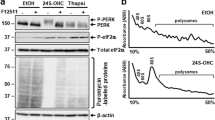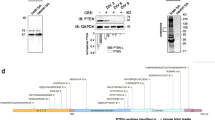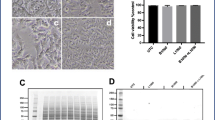Abstract
Transglutaminase 2 has been postulated to be involved in the pathogenesis of central nervous system neurodegenerative disorders. However, its role in neuronal cell death remains to be elucidated. Excitotoxicity is a common event underlying neurodegeneration. We aimed to evaluate the protein targets for transglutaminase 2 in cell response to NMDA-induced excitotoxic stress, using SH-SY5Y neuroblastoma cells which express high tranglutaminase 2 levels upon retinoic acid-driven differentiation toward neurons. NMDA-evoked calcium increase led to transglutaminase 2 activation that mediated cell survival, as at first suggested by the exacerbation of NMDA toxicity in the presence of R283, a synthetic competitive inhibitor of transglutaminase active site. Assays of R283-mediated transglutaminase inhibition showed the involvement of enzyme activity in NMDA-induced reduction in protein basal levels of pro-apoptotic caspase-3 and the stress protein Hsp20. However, this occurred in a way different from protein cross-linking, given that macromolecular assemblies were not observed in our experimental conditions for both proteins. Co-immunoprecipitation experiments provided evidence for the interaction, in basal conditions, between transglutaminase 2 and Hsp20, as well as between Hsp20 and Hsp27, a major anti-apoptotic protein promoting caspase-3 inactivation and degradation. NMDA treatment disrupted both these interactions that were restored upon transglutaminase 2 inhibition with R283. These results suggest that transglutaminase 2 might be protective against NMDA-evoked excitotoxic insult in neuronal-like SH-SY5Y cells in a way, independent from transamidation that likely involves its interaction with the complex Hsp20/Hsp27 playing a pro-survival role.




Similar content being viewed by others
References
Arundine M, Tymianski M (2003) Molecular mechanisms of calcium-dependent neurodegeneration in excitotoxicity. Cell Calcium 34:325–337
Beck KA, De Girolamo LA, Griffin M, Billett EE (2006) The role of tissue transglutaminase in 1-methyl-4-phenylpyridinium (MPP+)-induced toxicity in differentiated human SH-SY5Y neuroblastoma cells. Neurosci Lett 405:46–51
Boros S, Kamps B, Wunderink L, de Bruijn W, de Jong WW, Boelens WC (2004) Transglutaminase catalyzes differential crosslinking of small heat shock proteins and amyloid-beta. FEBS Lett 576(1–2):57–62
Caccamo D, Currò M, Cusumano G, Crisafulli G, Ientile R (2004) Excitotoxin-induced changes in tranglutaminase during differentiation of cerebellar granule cells. Amino Acids 26:197–201
Fèsus L, Szondy Z (2005) Transglutaminase 2 in the balance of cell death and survival. FEBS Lett 579:3927–3302
Filiano AJ, Bailey CD, Tucholski J, Gundemir S, Johnson GV (2008) Transglutaminase 2 protects against ischemic insult, interacts with HIF1beta, and attenuates HIF1 signaling. FASEB J 22(8):2662–2675
Folk JE, Finlayson JS (1977) The epsilon-(gamma-glutamyl)lysine crosslink and the catalytic role of transglutaminases. Adv Protein Chem 31:1–133
Griffin M, Casadio R, Bergamini CM (2002) Transglutaminases: nature’s biological glues. Biochem J 368(Pt 2):377–396
Gundemir S, Johnson GV (2009) Intracellular localization and conformational state of transglutaminase 2: implications for cell death. PLoS One 4(7):e6123
Ientile R, Caccamo D, Macaione V, Torre V, Macaione S (2002) NMDA-evoked excitotoxicity increases tissue transglutaminase in cerebellar granule cells. Neuroscience 115(3):723–729
Ientile R, Caccamo D, Griffin M (2007) Tissue transglutaminase and the stress response. Amino Acids 33:385–394
Jeitner TM, Pinto JT, Krasnikov BF, Horswill M, Cooper AJL (2009) Transglutaminases and neurodegeneration. J Neurochem 109:160–166
Jellinger KA (2009) Recent advances in our understanding of neurodegeneration. J Neural Transm 116(9):1111–1162
Park D, Choi SS, Ha KS (2010) Transglutaminase 2: a multi-functional protein in multiple subcellular compartments. Amino Acids 39:619–631
Smethurst PA, Griffin M (1996) Measurement of tissue transglutaminase activity in a permeabilized cell system: its regulation by Ca2+ and nucleotides. Biochem J 313:803–808
Stetler RA, Signore AP, Gao Y, Cao G, Chen J (2009) HSP27: mechanisms of cellular protection against neuronal injury. Curr Mol Med 9(7):863–872
Tucholski J, Lesort M, Johnson GVW (2001) Tissue transglutaminase is essential for neurite outgrowth in human neuroblastoma SH-SY5Y cells. Neuroscience 102(2):481–491
Tucholski J, Roth KA, Johnson GVW (2006) Tissue transglutaminase overexpression in the brain potentiated calcium-induced hippocampal damage. J Neurochem 97:582–594
Yamaguchi H, Wang HG (2006) Tissue transglutaminase serves as an inhibitor of apoptosis by cross-linking caspase 3 in thapsigargin-treated cells. Mol Cell Biol 26(2):569–579
Zhang J, Lesort M, Guttmann RP, Johnson GVW (1998) Modulation of the in situ activity of tissue transglutaminase by calcium and GTP. J Biol Chem 273:2288–2295
Acknowledgments
This work was partly funded by Aston University.
Conflict of interest
There is no conflict of interest.
Author information
Authors and Affiliations
Corresponding author
Rights and permissions
About this article
Cite this article
Caccamo, D., Condello, S., Ferlazzo, N. et al. Transglutaminase 2 interaction with small heat shock proteins mediate cell survival upon excitotoxic stress. Amino Acids 44, 151–159 (2013). https://doi.org/10.1007/s00726-011-1083-z
Received:
Accepted:
Published:
Issue Date:
DOI: https://doi.org/10.1007/s00726-011-1083-z




